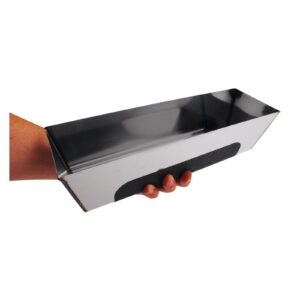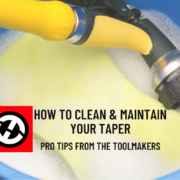When it comes to drywall finishing, the tools you choose can significantly impact the efficiency and quality of your work. Two essential tools that are often debated are the drywall hawk and the mud pan. While both serve the purpose of holding drywall joint compound, they are very different in design, usage, and suitability for various tasks. If you are wondering which one will work best for you, we have compared both tools below so you can decide.
What is a Drywall Hawk?

A drywall hawk is one of the most ancient tools that humans still use. Though it probably started as a mortar hawk for stonemasons, it has been used by craftsmen for centuries as a way to carry plaster, mortar, and other construction semisolids. It is a flat, square platform with a handle underneath, and it is used to hold mud or mortar for applying on a wall. It’s a tool favored by many seasoned professionals, particularly for large-scale projects or tasks requiring significant amounts of joint compound. The hawk allows you to carry large amounts of drywall mud, making it ideal for wide areas like ceilings or large walls.
Using a hawk requires some skill, balance, and practice. You hold the handle with your one hand, keeping the platform level while using a trowel in your other hand to scoop and apply mud. This setup is excellent for achieving smooth, consistent finishes over large areas. However, it’s not the best choice for tight spaces or intricate work, as its size can make maneuvering challenging. It may also not be the best choice for a DIY project or a novice in wall-finishing, so you may opt to use a mud pan instead.
The Trusty Mud Pan
A mud pan, on the other hand, is a long, narrow container typically made of stainless steel or plastic. It’s designed to hold smaller amounts of joint compound and is often used with drywall finishing knives. Mud pans are more beginner-friendly, as they are easy to hold and maneuver, especially using one hand in confined spaces like corners or around fixtures. They are designed to be held using only one hand or to sit on a flat surface, freeing up your other hand to apply the drywall joint compound to your project.
Mud pans are also ideal for taping seams, feathering edges, and for patching or repair work. Their compact size allows you to pack them into small spaces, and they come in multiple sizes, allowing you to find the perfect size for your needs. Most mud pans are shaped to compliment the shape of most finishing knives, and many now offer pans with curved bottoms so that it fits more comfortably into your hand while you work. Mud pans can be made of almost any material, but most professionals prefer metal pans for their durability and ease-of-cleaning.

Which Should You Choose?
The choice between a drywall hawk and a mud pan largely depends on your experience level and the size of the project. If you’re a seasoned professional working on large surfaces or installing whole rooms, then you already know the hawk offers more speed and efficiency over the pan. For DIYers, novice finishers, or tasks in small spaces, the mud pan is a more practical option. Ultimately, mastering both tools can give you the flexibility to tackle a variety of drywall finishing challenges with confidence. No matter which you decide, you will find that both tools have been modernized for comfort.
Wall Tools has the largest selection of drywall hawks, mud pans, plastering tools, automatic taping tools, banjos, and more!



